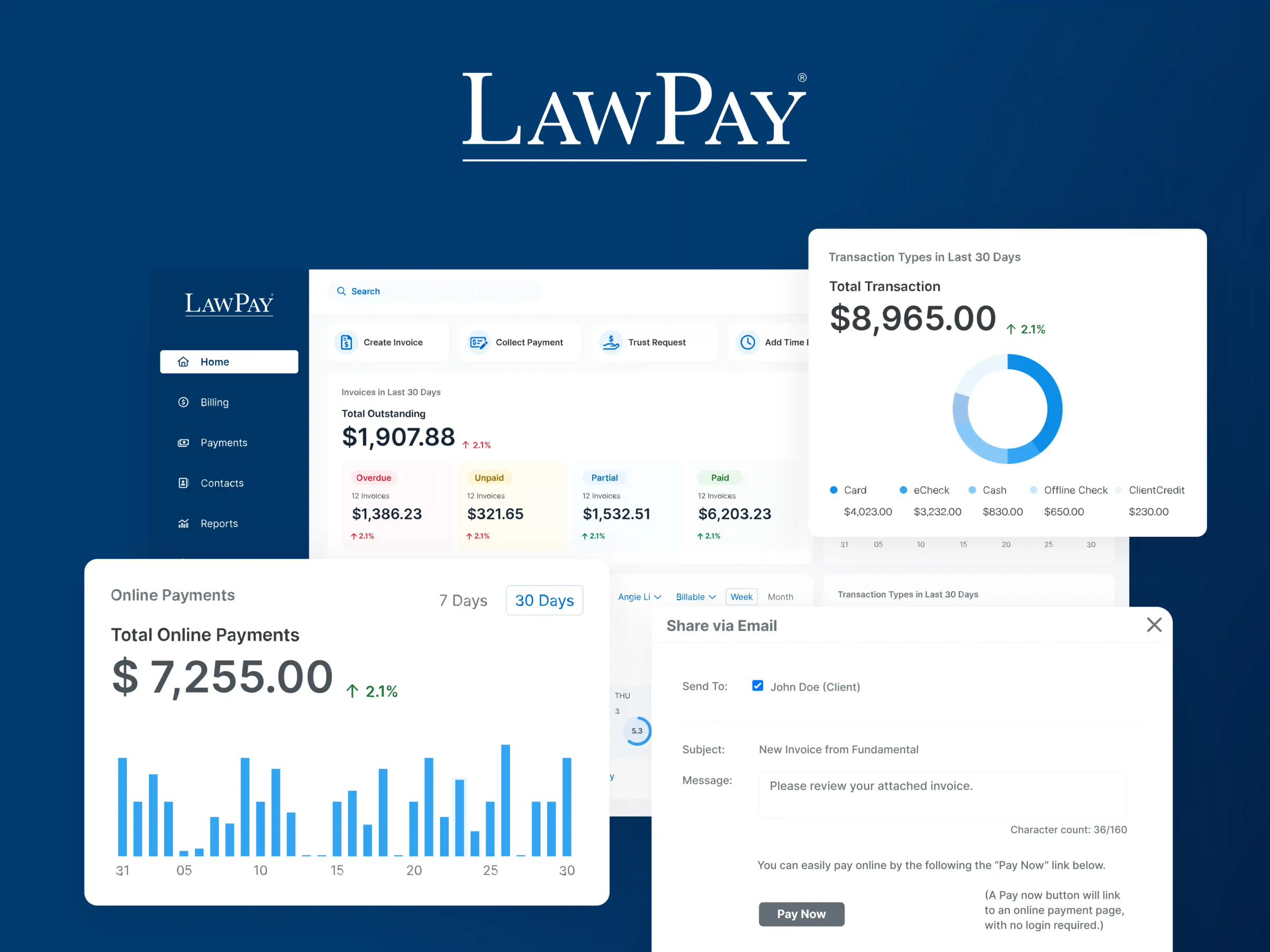Billable hours play a pivotal role in the profitability and success of law firms. They're also a key metric for lawyers to meet their firm’s minimum quota and maximize time spent on their practice.
With some attorneys clocking in more than 40 total hours per week according to the U.S. Bureau of Labor Statistics, lawyers don’t have time to lose.
Attorneys must either interrupt their workflow to log hours in real time or rely on their memory to record billable work. Formatting inconsistencies can also add another lay of complexity. For example, tracking only the start and end time for each task will require manual calculation to finalize the total time worked.
A billable hours chart streamlines the timekeeping process by standardizing time entries. It’s simple for lawyers to use and easy for clients to understand, and it helps law firms create more accurate invoicing and a better client experience.
What Is a Billable Hours Chart?
A billable hours chart is a standardized template that helps users track, calculate, and invoice clients based on increments of an hour spent on billable work. This timekeeping method for lawyers is a more accurate and transparent approach to tracking hours, helping them avoid common invoicing mistakes—like over or underbilling for services rendered.
Law firms can use any increment of time for their billable hours chart. For example, some may log in 10 or 15-minute increments. However, many apply six-minute increments as an industry standard.
Why Do Lawyers Use a Six-Minute Increment Chart?
Most attorneys use six-minute increments (one-tenth of an hour) for clarity and efficiency during invoicing.
Anything smaller can be time-consuming and laborious. On the other hand, billing in larger increments can cause excessive padding and discrepancies for clients between the amount owed and the actual work performed.
Calculating billable hours in six-minute increments is a fair compromise for tracking time with precision, transparency, and a touch of flexibility.
Sample Attorney Billable Hours Chart
The chart below uses six-minute billing time increments. We encourage you to save this chart or bookmark this page for future use. You can also save an image version of our billable hours chart to email or print for your firm.
Minutes | Billing Increment |
|---|---|
1-6 | 0.1 |
7-12 | 0.2 |
13 -18 | 0.3 |
19 - 24 | 0.4 |
25-30 | 0.5 |
31-36 | 0.6 |
37-42 | 0.7 |
43-48 | 0.8 |
49-54 | 0.9 |
55-60 | 1.0 |
How To Use a Billable Hours Chart
To calculate billable hours worked, locate the number of minutes in the left column, then record the billing increment to its right.
For example, say it takes 14 minutes to respond to a client’s email. We can use our lawyer billable hours chart to take the following steps:
Find the time range for our entry in the “Minutes” column. Our example falls in the 13-18 minute range.
To confirm the billing increment, follow the row to the “Billing Increment” column. For our example, we’d record .3 in our individual attorney timesheet.
Here’s another attorney billable hours example: Imagine it took six hours and 28 minutes to research a client’s case. In this scenario, you would bill 6.5. That is 1.0 for each of the six hours and 0.5 for the 28 minutes.
How Can a Legal Billable Hours Chart Help Attorneys More Accurately Track Time?
Instead of manual and time-consuming calculations, a lawyer billable hours chart makes tracking and logging billable time easier and faster.
Lawyers can accomplish the following when using a billable hours chart:
Easily convert six-minute increments to a billable hour
Accurately invoice clients for legal services
Spend less time on manual calculations
Gain time to work billable hours
Lawyers can also help minimize the following billing bad habits by using a standardized chart:
Bill blocking or bill padding
Underbilling for services rendered
Billing for office overhead and administrative tasks
Delaying invoice creation and delivery
Billable Hours vs. Non-Billable Hours
Whether you’re tracking time with a legal billable hours chart or a legal case management system, knowing how to differentiate billable vs. non-billable hours is crucial for accurate timekeeping.
Billable hours are the time a lawyer spends that requires compensation from the client.
A few examples of attorney billable hours include:
Performing research directly related to a client’s case
Developing a client’s case
Responding to a client’s correspondence
Meeting with clients or other persons on the case
Revising a case
Non-billable hours cannot be charged to a client but play an integral role in the firm’s day-to-day operations.
A few examples of attorney non-billable hours include:
Reporting on quarterly metrics
Responding to internal emails
Participating in team meetings
Attending a networking event
Completing administrative tasks
Performing charitable work
If you’re unsure if an activity is considered billable or non-billable, here are a few questions to ask yourself:
Was the work a necessary component of the case?
Did the client agree to the task in advance?
Did the time spent fulfill a client’s needs?
If you answered yes to any of these questions, you can bill according to the six-minute increment chart.
Best Practices for Using a Billable Hours Chart
While billable hours charts are easy to use, lawyers should follow these best practices to ensure they’re logging time accurately.
Track in Real Time
The most accurate billing comes from tracking as you go. With a lawyer’s never-ending workload, it’s easy to forget about small tasks. Lost hours can quickly add up to a substantial loss of revenue. Tracking in real-time makes it easier to stay on top of your hours and differentiate billable time vs. actual time worked.
Track Time Accurately
While it may be tempting to round up to the nearest hour, padding hours is unethical and unwarranted. Accurately tracking time makes it easier to maximize billable hours and analyze your law firm’s utilization rate at a high level. It’s also crucial to correctly categorize billable and non-billable time to ensure correctly charging for services rendered.
Use Detailed Descriptions
Descriptions should be straightforward enough for clients to understand but detailed enough to help jog your memory in the case of a potential dispute. Clear legal billing language can help clients understand the work performed and time spent on their cases.
Let's look at two sample attorney billing entries:
Bad example: “Attorney services”
Good example: “Initial consultation with client”
The bad example doesn’t tell us anything specific about the service or work performed. It’s far too broad and would leave a client wondering what exactly went into these “attorney services.”
The good example is much clearer. A client can read and understand exactly when and what work was performed.
Communicate Early and Often With the Client
Transparency is key to nurturing a strong attorney-client relationship when discussing your firm’s billing practices. You’ll want to clearly explain your firm’s rates and billing process early so clients can ask questions and understand expectations for future payments.
You can solidify mutual understanding through the appropriate paperwork. Below are a couple of example documents that can clear up potential confusion:
An attorney fee agreement outlines all payment-related information necessary to render legal services. It can include how fees are calculated and what expenses are the client’s responsibility.
Credit card authorization forms outline when clients will be invoiced, for how much, and from which account. You can use this for one-time or recurring payments.
Checking in with clients can also help minimize confusion and avoid potential disputes.
Download our e-book, "The Billable Hour Reimagined," to learn more about billing best practices and how technology can help streamline your invoicing process.
A Better Time Tracking Solution: Legal Payment Software
A billable hours chart is a crucial tool for time tracking—but it’s not the only one available to your firm. Legal payment software can help streamline time tracking along with many other aspects of your firm's billing process.
Whether logging a call, uploading supporting documents, or attending a court hearing, the best law firm timekeeping solutions account for every minute. And when time is money, there’s no better way to make the most of it.
For example, LawPay gives law firms the tools they need to track time accurately and run their business while they’re on the go.
With the LawPay time tracking feature, you can:
Automatically track time on calls and emails.
Get prompts to track time when performing billable activities.
Easily locate billable time that may otherwise have fallen through the cracks.
Create invoices that accurately reflect your billable time.
Monitor how much time you’ve spent on a case.
Save default sample attorney billing entries to save time re-entering descriptions for recurring tasks.
Ultimately, using legal payment management software is a reliable way to streamline your time-tracking process and free up space for more billable tasks.
Start Tracking Billable Hours More Efficiently
Lawyers have enough on their plates, and meticulous timekeeping with a billable hours chart isn’t nearly as rewarding as working a case. Keep your firm’s attorneys focused on their practice with legal software that streamlines the timekeeping process and mitigates errors.
With LawPay, we provide law firms with a holistic solution for payment processing and case management.
We help firms:
Track time spent on billable and non-billable hours.
Identify billable activities with a proprietary Smart Time Finder.
Send customizable invoices.
Accept payments through a variety of methods.
Schedule recurring payments to minimize late payments.
Use data-driven legal financial reporting to track and maximize your cash flow.
To implement an effective strategy and get the most out of your firm’s billable hours, schedule a demo today.
Schedule a demo to see what LawPay can offer your firm.
Book Now
About the author

Gabriela JheanContent Writer
Gabriela Jhean is a Content Writer for leading legal software companies, including MyCase, Docketwise, CPACharge, CASEpeer, and LawPay—the #1 legal payment processor. She covers emerging legal technology, financial wellness for law firms, the latest industry trends, and more.
